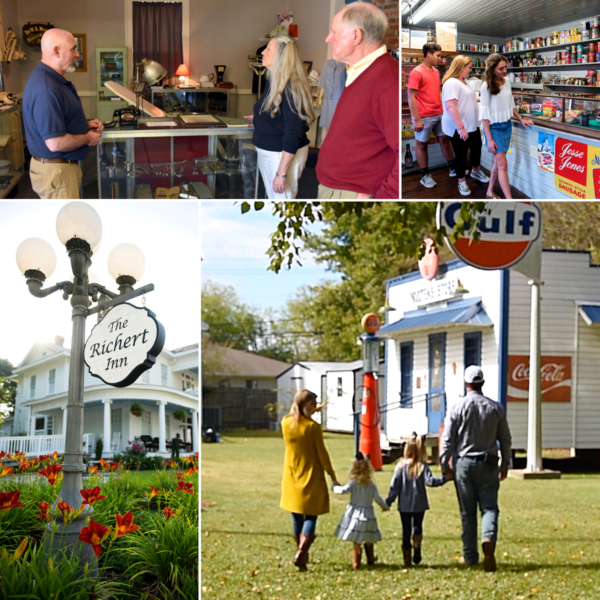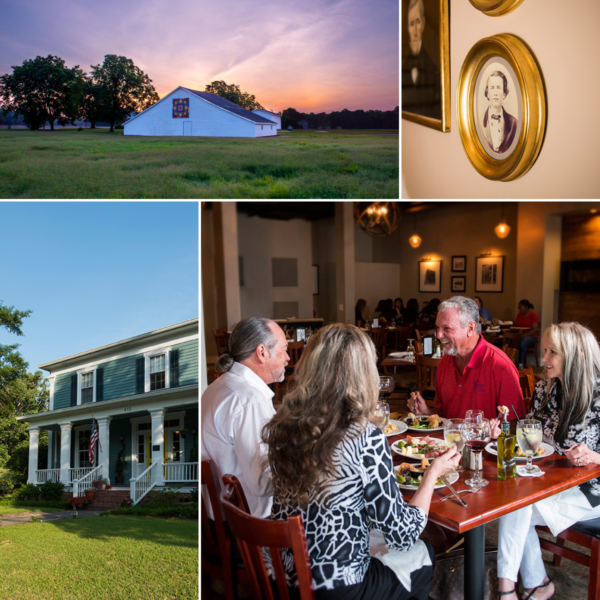
Tucked into the coastal plains of Eastern North Carolina is Sampson County, a collection of eight charming rural small towns rich with history and heritage going back hundreds, even thousands of years. If you consider yourself a history buff, it’s the perfect place to explore and spend a day or two relaxing and even finding your family roots!
Sampson County was settled by colonials of Scottish heritage and the Coharie Native American Indian Tribe over 5,000 years ago. Some say that the Coharie Tribe came to the area from Virginia and were remnants of the Lost Colony. Today, their cultural heritage is alive and very active in Sampson County. The Coharie hold their Annual Cultural POW WOW Festival each September at the Coharie Tribal Community Center located along US 421. You can also stop by any time of year to see their large beautiful display gallery filled with local Coharie Indian heritage artifacts.
The City of Clinton is the county seat and was founded back in 1784, having been named after a Brigadier General of the North Carolina militia. The first Sampson County Courthouse was built in the fall of 1784 and was constructed of heavy hewn logs. It sat on the very site of the present iconic and beautiful courthouse located in the middle of the town square that is surrounded by quaint shops and a few locally-owned restaurants.
INSIDER TIP: Directly across the street from the courthouse is Alfredo’s, one of the best Italian restaurants in Eastern North Carolina. It’s a great place for both lunch and dinner Tuesday through Saturday. They also have a spacious and well-appointed coffee bar, serving craft coffees starting at 7 am open Tuesday through Saturday – amazing!
The Sampson County History Museum Village is the crown jewel of Sampson County’s historical attractions, highlighting the land and inhabitants of this area, since the 1700s. Founded in 1997, it’s grown from a single house to a “village” of eleven buildings on a two-acre campus. Some of the buildings are historic structures relocated from elsewhere in the county, such as 18th-century log cabins, a Civil War-era farmhouse, and a 1920s general store. The newest addition is the Military and Veterans Building which had its grand opening in 2019.
While out and about strolling in Downtown Clinton, enjoy the quaint shops and local small businesses, and also the architecture and old homes on a self-guided walking tour of historic buildings in Downtown Clinton. It’s a great way to spend a beautiful day in Eastern North Carolina!

Civil War history buffs might be interested to know that Theophilus H. Holmes, was the son of North Carolina Governor Gabriel Holmes, and was born on the family plantation near the present-day Town of Roseboro in 1804. He received an appointment to the U. S. Military Academy at West Point and graduated in the Class of 1829 with Robert E. Lee. With the outbreak of the Civil War, Holmes resigned his commission and joined the Confederate Army. Rising to the rank of Lieutenant General, Holmes was the highest-ranking Confederate officer from North Carolina.

Here are 5 Interesting Historical Trivia Facts About Sampson County!
- The Town of Autryville is named after Sampson County native, Micajah Autry, an American merchant, poet, and lawyer who died in the Texas Revolution at the Battle of the Alamo. In the fall of 1835, he left his home in Tennessee with his good friend, Davy Crockett, to help with the Texas War for Independence from Mexico.
- House’s Mill (now House-Autry Mill) near Newton Grove is the oldest continuously operating gristmill in North Carolina, having ground flour and meal since 1812.
- The Cape Fear & Yadkin Valley Railroad was built in 1886 and ran from Sanford to Wilmington. In 1910, a Roseboro couple could purchase a round-trip train ticket to Wilmington for $1.30 each. Arriving there by 10:30 am, they could eat a seafood lunch, spend the afternoon at Carolina Beach, leave Wilmington by 5:30 pm and be home that night in time for dinner.
- Tired of patching up her railroad worker husband’s clothing, Abigail Carter, of Clinton, took a patch of canvas and a pair of dungarees and combined them to create the first pair of bib overalls. Carter opened up a business and became the first manufacturer of bib overalls in the United States.
- The Black River, in Sampson County, is one of the few waterways left that hasn’t been cut by man. A tree called Methuselah, or BLK69 by its official name, dates back to at least 364 AD and has been verified to be the oldest tree in eastern America.
INSIDER TIP: Today, the Black River is a hot spot for paddling enthusiasts with guided tours organized by the Coharie Tribal Community and Friends of Sampson County Waterways.
Do you have ancestors that are from Sampson County and Eastern North Carolina? Enjoy researching your family tree and finding your roots in Downtown Clinton in the Genealogy Room at the public library. You never know what discoveries you will find. Sampson County’s towns are full of hidden treasures of great local food, shops, and American folk art. Hop in the car, drive our country roads and go exploring along Sampson County’s Barn Quilt Trail. Each of our small towns has something unique to offer that we attribute to our local residents with an entrepreneurial spirit.
Enjoy a stay at a historic bed & breakfast inn located in historic downtown Clinton! The Ashford Inn was built around 1839 and purchased by Colonel John Ashford, a Civil War veteran, in 1869. It’s a Greek Revival house with full corner pilasters and boxed cornices, as well as a three-bay porch with classic pillars.
You’ll also find we have great hotel accommodations centrally located in Clinton that are safe, clean, and ready to greet you with true southern hospitality. Feel free to stop by the Sampson County Tourism office to pick up brochures and maps or just to say hello and ask questions. We look forward to seeing you and hope you cultivate your spirit in Sampson County!






